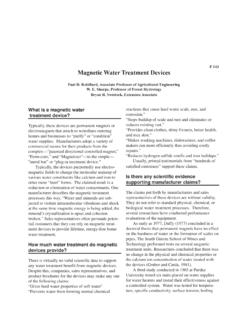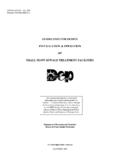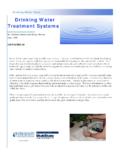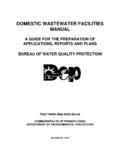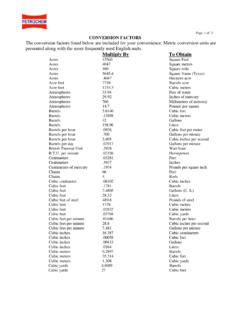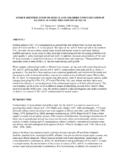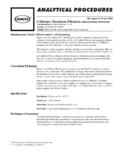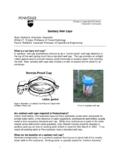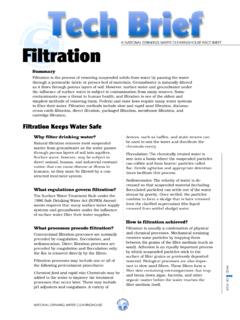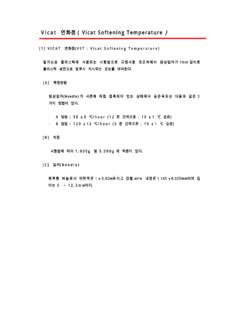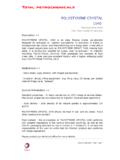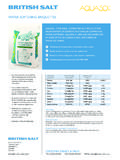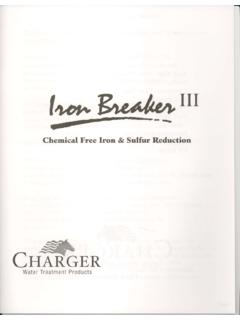Transcription of Fact Sheet 08 Insert - Water Research
1 PAGE OF FOURNATIONAL DRINKING Water CLEARINGHOUSE oneA NATIONAL DRINKING Water CLEARINGHOUSE FACT SHEETLime SofteningWhat is hard Water ? Hardness in Water is primarily the result ofconcentrations of calcium and , some Water utilities remove calcium andmagnesium to soften the Water and improve itsquality for domestic use. Other ions that pro-duce hardness include iron, manganese,strontium, barium, zinc, and aluminum, butthese ions are generally not present in signifi-cant quantities. Therefore, total hardness isusually defined as the sum of magnesium andcalcium hardness in milligrams per liter (mg/L),as calcium carbonate (CaCO3). Total hardnesscan also be differentiated into carbonate andnoncarbonate hardness. Carbonate hardness isthe portion of total hardness present in theform of bicarbonate salts [Ca(HCO3)2 andMg(HCO3)2] and carbonate compounds (CaCO3and MgCO3).
2 Noncarbonate hardness is the portion of cal-cium and magnesium present as noncarbonatesalts, such as calcium sulfate (CaSO4), calciumchloride (CaCl2), magnesium sulfate (MgSO4),and magnesium chloride (MgCl). The sum ofcarbonate and noncarbonate hardness equalstotal Water can cause scaling problems in Water heaters and soap does not lather well inhard Water . Therefore, some Water utilities soften Water to improve its quality for domesticuse. lime softening is best suited to groundwater sources, which have relatively stable waterquality. The combination of variable source Water quality and the complexity of the chemistryof lime softening may make lime softening too complex for small systems that use surfacewater lime softening has been used successfully by groundwater systems serving fewerthan 3,000 people, it is unlikely to be suitable for treating groundwater in systems serving500 or fewer people unless those systems have some form of contract or satellite operationthat would enable a trained operator to monitor the treatment process.
3 Prefabricated limesoftening equipment is available for small systems. Also, there is an American Water WorksAssociation Standard for quicklime and hydrated lime (ANSI/AWWA B202-93) that providespurchasers, manufacturers, and suppliers with the minimum requirements, includingphysical, chemical, packaging, shipping, and testing hydrated lime [Ca(OH)2] or quicklime (CaO) may be used in the softening process. Thechoice depends upon economic factors, such as the relative cost per ton of the two materialsas well as the size and equipment of the softening plant. Hydrated lime is generally usedmore in smaller plants because it stores better and does not require slaking (producing achemical change in lime by combining it with Water ) equipment. On the other hand, quick-lime costs less per ton of available calcium oxide and is thus more economical for use inlarge Water has high causticity and scale-formation potential; hence, recarbonation isemployed to reduce pH and mitigate scaling of downstream processes and pipelines.
4 Onsitecombustion generation of carbon dioxide (CO2) or liquid CO2 is the most common source ofcarbon dioxide for OF FOUR EIGHT June 1998twoLime softening What may be hard Water in one area maybe perfectly acceptable Water in another general, the degree of hardness is classifiedas follows:For most applications, total hardness of 120mg/L or less and magnesium hardness of 40mg/L or less appear to be acceptable designcriteria for softening does the lime-softeningprocess work?In the lime- softening process, the pH of thewater being treated is raised sufficiently toprecipitate calcium carbonate and, if necessary,magnesium hydroxide. The normal pH of wateris between In small systems, limesoftening is typically practiced by addinghydrated lime to raw Water to raise the pH toapproximately 10.
5 This removes calcium car-bonate, essentially limestone. If magnesiumremoval is also required, the pH during soften-ing needs to be closer to 11. Lime-softeningsystems need not be pilot tested for smallsystems using groundwater sources. Jar testingto determine appropriate process pH andchemical doses is sufficient. Doses of thesechemicals should not change greatly over timeunless the groundwater is subject to periodicinfiltration by surface Water that changes inquality. Lime- softening systems do need to bepilot tested if used on surface Water sourceswith variable pretreatment is used?The principal types of pretreatment used beforelime softening are aeration and may be used to remove carbon dioxidefrom the source Water before softening . This isonly applicable to groundwaters where carbondioxide concentrations are relatively high. Limeremoval of carbon dioxide in source Water addsto operation costs because of chemical expensesand increased calcium carbonate draft or open tray aeration is oftenused and may reduce the carbon dioxide level to10 mg/L or less.
6 Aeration also oxidizes iron andmanganese; clogging of the aeration tray is is used primarily by thoseplants treating high turbidity surface are the monitoring andoperating requirements?Regulatory monitoring requirements for limesoftening plants depend on whether the sourcewater is surface Water or groundwater. Processmonitoring requirements should focus onmeasurement of pH, hardness, and alkalinityfor plants treating groundwater. In addition,filtered Water turbidity monitoring is needed atthe plants treating surface Water for compliancepurposes, as well as to manage filter of the difficult aspects of lime softening isthe operation and maintenance of lime feedersand lines carrying lime slurry to the point ofapplication. In addition, plant operators mustunderstand lime softening chemistry. Measure-ment of pH must be accurate, and the operatormust know that the pH meter is properlycalibrated.
7 Failure to maintain the proper pH insoftened Water prior to filtration at a limesoftening plant could result in precipitation orexcess lime in the filter beds and formation ofcalcium carbonate deposits within the are the chemicalrequirements?The amount of lime required to remove carbon-ate hardness and magnesium can be calculatedusing in the following equation:CaO (lb/mil gal) = CO2 (mg/L) + [alkalinity(mg/L) + magnesium hardness (mg/L) + X]Where CaO is 100 percent pure, CO2 is ex-pressed as CO2, alkalinity is expressed asCaCO3, and X is the required excess hydroxidealkalinity in mg/L as CaCO3. The magnesiumhardness shown is the amount to be removedby softening , and not the amount excess alkalinity can be determinedfrom the magnesium hydroxide solubilityrelationship: it is typically in the range of 30 to70 mg/l and is often estimated at 50 mg/Lexpressed as mg/L as CaCO3 Soft0 to 75 Moderate75 to 150 Hard150 to 300 Very hardAbove 300 Source: Water Treatment Plant Design, OF FOURNATIONAL DRINKING Water CLEARINGHOUSE threeWhat are other softeningalternatives?
8 The selection of lime, lime-soda ash, or causticsoda softening is based on cost, total dissolvedsolids criteria, sludge production, carbonateand noncarbonate hardness, and chemicalstability. Water containing little or nononcarbonate hardness can be softened withlime alone. However, Water with highnoncarbonate hardness may require both limeand soda ash to achieve the desired finishedwater hardness. softening with lime or lime-soda ash is generally less expensive thancaustic softening . Caustic soda softeningincreases the total dissolved solids of treatedwater, while lime and lime-soda ash softeningoften decrease total dissolved solids. Causticsoda softening produces less sludge than limeand lime-soda ash softening . Caustic soda doesnot deteriorate during storage, while hydratedlime may absorb carbon dioxide and waterduring storage, and quicklime may slake instorage causing feeding problems.
9 The finalselection is generally based on cost, waterquality, and owner and operator are the benefits ofsoftening?Potential benefits of softening Water at a centraltreatment plant include the following: reducing dissolved minerals and scale-forming tendencies, reducing consumption of household cleaningagents, removing radium 226 and 228, removing arsenic and uranium, removing heavy metals, supplementing disinfection and reducingalgal growths in basins, removing certain organic compounds andreducing total organic carbon (TOC), removing silica and fluoride, removing iron and manganese, reducing turbidity of surface waters inconjunction with the hardness precipitationprocess, increasing the Langelier Saturation Index,useful for corrosion control under someconditions, and possibly removes Giardia Lamblia there concerns about softwater?
10 In most cases, for consumer use, relatively softwater is preferable; however, it does haveseveral disadvantages. Excessively soft watercan cause corrosion in pipes. This corrosion canshorten the service life of pipes and householdappliances and can result in toxic materials,such as lead and cadmium, being dissolved indrinking Water . The decision to soften a watersupply depends completely on the Water regulations do not generallyrequire about lime softeningresiduals?All Water softening plants, large or small, arenow required to refrain from directly discharg-ing any wastes liquid or solid into riversor streams. Where abandoned stonequarries, sand and gravel pits, or coalmines are available nearby, it may bepossible to dispose of the sludge formany years without any seriousdifficulty. In areas where there areabandoned coal-strip mines, pumpingthe sludge into these areas may be alogical and convenient solution.
